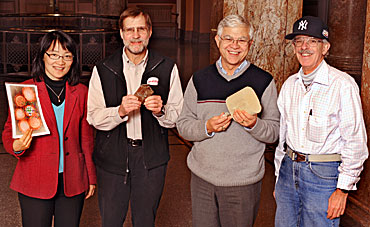Iowa State, Ames Laboratory researchers named AAAS Fellows for distinguished work
12-17-09

These four researchers from Iowa State University and the U.S. Department of Energy's Ames Laboratory have been named Fellows of the American Association for the Advancement of Science. They are, left to right, Mei Hong, who is holding an illustration of the structure of the M2 protein of influenza with an antiviral drug; Michael L. Thompson, who is holding a sample of mica, a mineral found in soil; Mufit Akinc, who is holding samples of ceramic materials, including a spring and a catalytic converter; and Mark Gordon, who knows computational chemistry and cheers for the Yankees. Photo by Bob Elbert.
Contacts:
Mufit Akinc, Materials Science and Engineering and Ames Laboratory, (515) 294-0738, makinc@iastate.edu
Mark Gordon, Chemistry and Ames Laboratory, (515) 294-0452, mark@si.msg.chem.iastate.edu
Mei Hong, Chemistry and Ames Laboratory, (515) 294-3521, mhong@iastate.edu
Michael L. Thompson, Agronomy and Ames Laboratory, (515) 294-2415, mlthomps@iastate.edu
Mike Krapfl, News Service, (515) 294-4917,
mkrapfl@iastate.edu
Iowa State, Ames Laboratory researchers named AAAS Fellows for distinguished work
AMES, Iowa - Four Iowa State University and Ames Laboratory researchers have been named Fellows of the American Association for the Advancement of Science (AAAS).
They are Mufit Akinc, a professor of materials science and engineering and associate scientist for the U.S. Department of Energy's Ames Laboratory; Mark Gordon, Distinguished Professor and Frances M. Craig Chair in chemistry, and Ames Laboratory senior chemist and director of the Lab's Mathematics and Computational Sciences Program; Mei Hong, John D. Corbett Professor of Chemistry and Ames Laboratory associate scientist; and Michael L. Thompson, Pioneer Hi-Bred Professor of Agronomy and Ames Laboratory associate scientist.
The researchers are being recognized by their peers within the association for "scientifically or socially distinguished efforts to advance science or its applications."
Iowa State researchers are being honored for their work in materials science, chemistry and agronomy:
● Akinc is being honored, according to the AAAS award citation, "For using chemistry to prepare advanced inorganic materials with tailored properties, such as infrared transmission in high-temperature applications." He's working on interdisciplinary projects that improve the properties and performance of materials by manipulating chemistry and processing methods, including the synthesis of nanomaterials inspired by biology.
● Gordon is being honored, "For outstanding achievement in the development of new computational models for research and education in the chemical, materials, and biological sciences." He's advancing theoretical and computational chemistry for complex molecular systems.
● Hong is being honored, "For distinguished contributions to the field of biophysical chemistry and solid-state NMR (nuclear magnetic resonance) spectroscopy, and for leadership in organizing scientific conferences advancing NMR." She's using advanced solid-state nuclear magnetic resonance techniques to determine the structures of membrane proteins important for human health, including influenza virus proteins and antimicrobial peptides.
● And Thompson is being honored, "For investigations of the fate and transport of organomineral complexes, phosphorous, and anthropogenic organic compounds in soils." He's studying the environmental applications of soil science, including the molecular-scale interactions of organic chemicals with soil minerals and organic matter.
The association will announce this year's class of 531 Fellows in the Dec. 18 issue of the journal Science. The new Fellows will be formally recognized on Feb. 20, 2010, at the AAAS Annual Meeting in San Diego.
The American Association for the Advancement of Science is the world's largest general scientific society and publisher of the journal Science. It was founded in 1948, includes some 262 affiliated societies and academies of science and serves 10 million people. Its mission is to "advance science and serve society."
-30-
